Figures & data

Table 1. Strains of Colletotrichum spp. studied, with collection details and GenBank accession numbers
Figure 1. The first of 430 equally most parsimonious trees obtained from a heuristic search of the combined ITS, sod2, apn2, and apn2/mat1 sequence alignment of the Graminicola species complex. Bootstrap support values above 50 % and Bayesian posterior probability values above 0.70 are shown at the nodes. Colletotrichum gloeosporioides strain CBS 112999 is used as outgroup. Numbers of types or ex-type strains are emphasized with an asterisk. The Caudatum subclade is indicated with a green bracket.
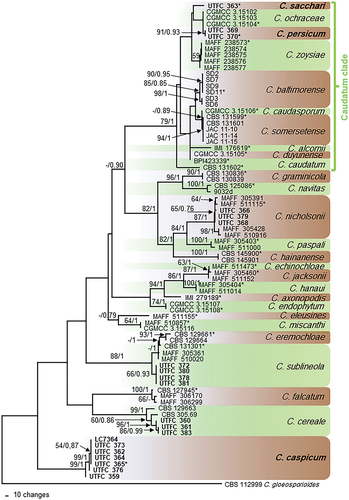
Figure 2. The first of 711 equally most parsimonious trees obtained from a heuristic search of the combined ITS, tub2, act, and gapdh sequence alignment of the Graminicola species complex. Bootstrap support values above 50 % and Bayesian posterior probability values above 0.70 are shown at the nodes. Colletotrichum gloeosporioides strain CBS 112999 is used as outgroup. Numbers of types or ex-type strains are emphasized with an asterisk. The Caudatum subclade is indicated with a blue bracket.
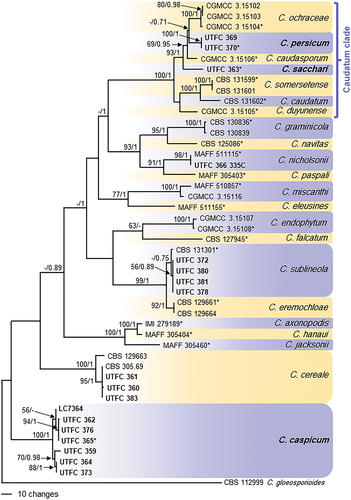
Figure 3. Colletotrichum caspicum (A–C, E, G, I–T from ex-holotype strain UTFC 365. D from strain UTFC 376. F, H from strain UTFC 373). A–B. Colony on OA after 7 d, A. upper and B. reverse side. C, H. Setae. D–E. Acervuli. F–G. Conidiophores. I–N. Appressoria. O–T. Conidia. C–H, O–T. from Anthriscus stem. I–N. from SNA. D, E. DM. C, F–T. DIC. Scale bars: D, E = 50 μm, C, F–T = 10 μm.

Figure 4. Colletotrichum cereale (from strain UTFC 383). A–B. Colony on OA after 7 d, A. upper and B. reverse side. C. Tip of a seta. D, E, H. Acervuli with setae. F, G. Conidiophores. I. Base of a seta. J–O. Appressoria. P. Conidia. C, F–I, P. from Anthriscus stem. D–E, J–O. from SNA. D, E. DM. C, F–P. DIC. Scale bars: D, E = 50 μm, C, F–P = 10 μm.
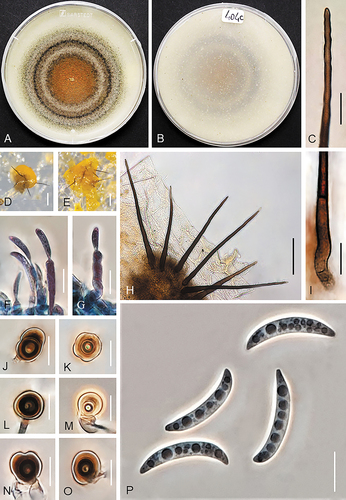
Figure 5. Colletotrichum nicholsonii (from strain UTFC 366). A. Colony on OA after 7 d. B. Colony on SNA amended with a double autoclaved stem of Anthriscus sylvestris and autoclaved filter paper. C. Seta. D, E. Acervuli. F, H. Conidiophores. G, O. Conidia. I–N. Appressoria. C, D. from Anthriscus stem. E. from autoclaved filter paper. F–O. from SNA. D–E. DM. C, F–O. DIC. Scale bars: D–E = 50 μm, C, F–O = 10 μm.
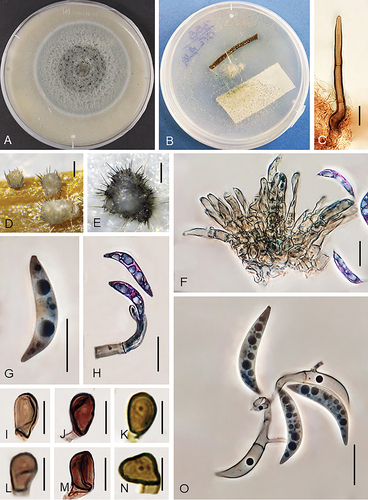
Figure 6. Colletotrichum persicum (from ex-holotype strain UTFC 370). A–B. Colony on OA after 7 d, A. upper and B. reverse side. C. Tip of a seta. D–F. Conidiophores. G. Basis of a seta. H–L. Conidia. M–R. Appressoria. C–L. from Anthriscus stem. M–R. from SNA. C–R. DIC. Scale bars: C–R = 10 μm.
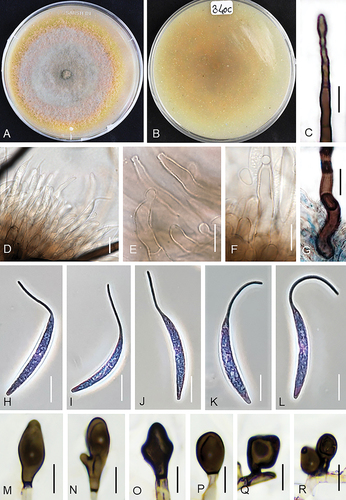
Figure 7. Colletotrichum sacchari (from ex-holotype strain UTFC 363). A–B. Colony on OA after 7 d, A. upper and B. reverse side. C. Seta. D. Acervuli. E–G. Conidiophores. H–L. Conidia. M–R. Appressoria. C–L. from Anthriscus stem. M–R. from SNA. D. DM. C, E–R. DIC. Scale bars: D = 50 μm, C, E–R = 10 μm.
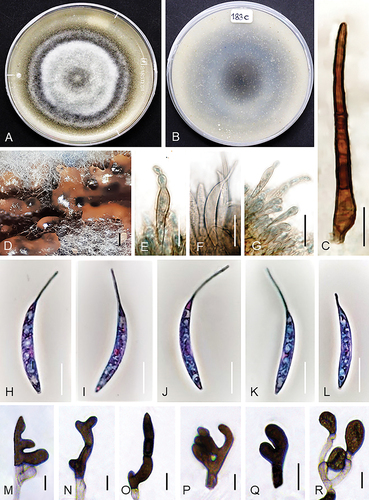
Figure 8. Colletotrichum sublineola (from strain UTFC 381). A–B. Colony on OA after 7 d, A. upper and B. reverse side. C. Tip of a seta. D, E. Acervuli. F. Conidiophores. G. Base of a seta. H, I, P. Conidia. J–O. Appressoria. C, G–I. from Anthriscus stem. D–F, J–P. from SNA. D, E. DM. C, F–P. DIC. Scale bars: D–E = 50 μm, C, F–P = 10 μm.
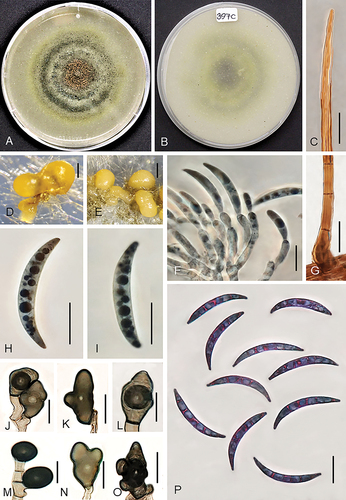
Figure 9. Wild Poaceae and Cyperaceae plants with symptoms of anthracnose or leaf spots from which Colletotrichum species were isolated in this study. A–B. Cyperus sp. (C. caspicum). C. Poaceae sp. (C. caspicum). D. Cynodon dactylon (C. caspicum). E. Lolium sp. (C. cereale). F–H. Paspalum dilatatum (C. nicholsonii). I–J. Phragmites australis (C. persicum). K–L. Saccharum spontaneum (C. sacchari). M. Anthracnose symptoms on Sorghum halepense (C. sublineola). N–P. Sorghum halepense (C. sublineola).

